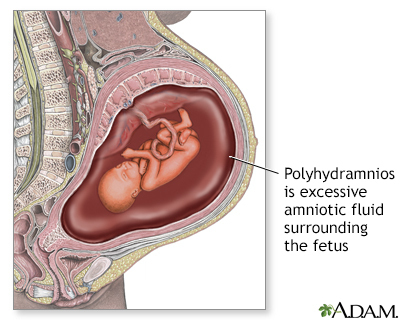Polyhydramnios
Definition
Polyhydramnios occurs when too much amniotic fluid builds up during pregnancy. It is also called amniotic fluid disorder, or hydramnios.
Alternative Names
Pregnancy - polyhydramnios; Hydramnios - polyhydramnios
Considerations
Amniotic fluid is the liquid that surrounds the baby in the womb (uterus). It comes from the baby's kidneys, and it goes into the uterus from the baby's urine. The fluid is absorbed when the baby swallows it and through breathing motions.
While in the womb, the baby floats in the amniotic fluid. It surrounds and cushions the infant during pregnancy. The amount of amniotic fluid is greatest at 34 to 36 weeks of pregnancy. Then the amount slowly decreases until the baby is born.
The amniotic fluid:
- Allows baby to move in the womb, promoting muscle and bone growth
- Helps baby's lungs to develop
- Protects the baby from heat loss by keeping the temperature constant
- Cushions and protects the baby from sudden blows from outside the womb
Causes
Polyhydramnios can occur if the baby does not swallow and absorb amniotic fluid in normal amounts. This can happen if the baby has certain health problems, including:
- Gastrointestinal disorders, such as duodenal atresia, esophageal atresia, gastroschisis, and diaphragmatic hernia
- Brain and nervous system problems, such as anencephaly and myotonic dystrophy
- Achondroplasia
- Beckwith-Wiedemann syndrome
It can also happen if the mother has poorly controlled diabetes.
Polyhydramnios also may occur if too much fluid is produced. This may be due to:
- Certain lung disorders in the baby
- Multiple pregnancy (for example, twins or triplets)
- Hydrops fetalis in the baby
Sometimes, no specific cause is found.
When to Contact a Medical Professional
Call your health care provider if you are pregnant and notice that your belly is getting large very quickly.
What to Expect at Your Office Visit
Your provider measures the size of your belly at every visit. This shows the size of your womb. If your womb is growing faster than expected, or it is larger than normal for your baby's gestational age, the provider may:
- Have you come back sooner than normal to check it again
- Do an ultrasound
If your provider finds a birth defect, you may need amniocentesis to test for a genetic defect.
Mild polyhydramnios that shows up later in pregnancy often doesn't cause serious problems.
Severe polyhydramnios may be treated with medicine or by having extra fluid removed.
Women with polyhydramnios are more likely to go into early labor. The baby will need to be delivered in a hospital. That way, the providers can immediately check the health of the mother and baby and give treatment if needed.
Gallery

References
Buhimschi CS, Mesiano S, Muglia LJ. Pathogenesis of spontaneous preterm birth. In: Resnik R, Lockwood CJ, Moore TR, Greene MF, Copel JA, Silver RM, eds. Creasy and Resnik's Maternal-Fetal Medicine: Principles and Practice. 8th ed. Philadelphia, PA: Elsevier; 2019:chap 7.
Gilbert WM. Amniotic fluid disorders. In: Landon MB, Galan HL, Jauniaux ERM, et al, eds. Gabbe's Obstetrics: Normal and Problem Pregnancies. 8th ed. Philadelphia, PA: Elsevier; 2021:chap 28.
Suhrie KR, Tabbah SM. The fetus. In: Kliegman RM, St. Geme JW, Blum NJ, Shah SS, Tasker RC, Wilson KM, eds. Nelson Textbook of Pediatrics. 21st ed. Philadelphia, PA: Elsevier; 2020:chap 115.
